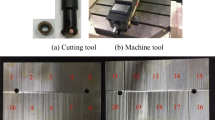Abstract
Several solutions can be considered to resolve the problem of positioning a cutting tool on a free-form surface when five-axis milling. To choose a unique solution, in addition to the cutter–workpiece contact, an additional criterion can be taken into account. This may concern the local geometry of the surface or yet again the width milled to maximise the metal removal rate, but technological criteria relating to the cutting phenomenon and the quality of the surface produced are not considered. The present article introduces a strategy applying positioning combined with balancing of the transversal cutting force. This method involves using the ploughing effect of the milling cutters by simultaneously engaging the teeth located to the front of the cutter in relation to the feed movement and also those to the rear. The positioning obtained stabilises the cutter and contributes to making a net improvement in its dynamic behaviour. This leads in turn to significantly higher quality of the milled surface. The article presents a method to apply balancing of the transversal cutting force to two types of machining passes and elaborates an associated strategy to plan cutter paths enabling an improvement in surface quality to be achieved.
Similar content being viewed by others
References
Kruth JP, Klewais P (1994) Optimization and dynamic adaptation of the cutter inclination during five-axis milling of sculptured surfaces. Ann CIRP 43(1):443–448
Jensen CG, Red WE, Pi J (2002) Tool selection for five-axis curvature matched machining. Comput Aided Des 34(3):251–266
Krzysztof M (1987) Influence of surface shape on admissible tool positions in 5-axis face milling. Comput Aided Des 19(5):233–236
Chen T, Ye P, Wang J (2005) Local interference detection and avoidance in five-axis NC machining of sculptured surfaces. Int J Adv Manuf Technol 25(3–4):343–349
Yuan-Shin L (1997) Admissible tool orientation control of gouging avoidance for 5-axis complex surface machining. Comput Aided Des 29(7):507–521
Jianhua F, Alan B (2008) Quadric method for cutter orientation in five-axis sculptured surface machining. Int J Mach Tool Manuf 48(7–8):788–801
Warkentin A, Ismail F, Bedi S (2000) Multi-point tool positioning strategy for 5-axis machining of sculptured surfaces. Comput Aided Geom Des 17(1):83–100
Gray PJ, Bedi S, Ismail F (2005) Arc-intersect method for 5-axis tool positioning. Comput Aided Des 37(7):663–674
Rubio W (1993) Génération de trajectoires du centre de l’outil pour l’usinage de surfaces complexes sur machines à trois et cinq axes. Thèse de doctorat, Université Paul Sabatier, Toulouse III
Patrick G, Frederic M, Walter R (2006) Modelling cutting forces in milling on torus cutters. Int J Mach Mach Mater 1:166–185, N°2
Gilles P, Monies F, Rubio W (2007) Optimum orientation of a torus milling cutter: method to balance the transversal cutting force. Int J Mach Tool Manuf 47(15):2263–2272
Gilles P, Cohen G, Monies F, Rubio W (2009) Dynamic behaviour improvement for a torus milling cutter using balance of the transversal cutting force. Int J Adv Manuf Technol 40(7–8):669–675
Gilles P, Cohen G, Monies F, Rubio W (2013) Torus cutter positioning in five-axis milling using balance of the transversal cutting force. Int J Adv Manuf Technol 66(5–8):965–973
Redonnet J-M, Rubio W, Monies F, Dessein G (2000) Optimising tool positioning for end-mill machining of free-form surfaces on 5-axis machines for both semi-finishing and finishing. Int J Adv Manuf Technol 16(6):383–391
Monies F, Mousseigne M, Redonnet J-M, Rubio W (2004) Determining a collision-free domain for the tool in five axis machining. Int J Prod Res 42(21):4513–4530
Gilles P, Senatore J, Segonds S, Monies F, Rubio W (2012) Determination of angular fields outside low and high collisions to mill free-form surfaces on 5-axis CNC machines. Int J Prod Res 50(4):1045–1061
Chiou C-J, Lee Y-S (1999) A shape-generating approach for multi-axis machining G-buffer models. Comput Aided Des 31(12):761–776
Author information
Authors and Affiliations
Corresponding author
Rights and permissions
About this article
Cite this article
Gilles, P., Cohen, G., Monies, F. et al. Machining strategy in five-axis milling using balance of the transversal cutting force. Int J Adv Manuf Technol 72, 1377–1387 (2014). https://doi.org/10.1007/s00170-014-5750-6
Received:
Accepted:
Published:
Issue Date:
DOI: https://doi.org/10.1007/s00170-014-5750-6




